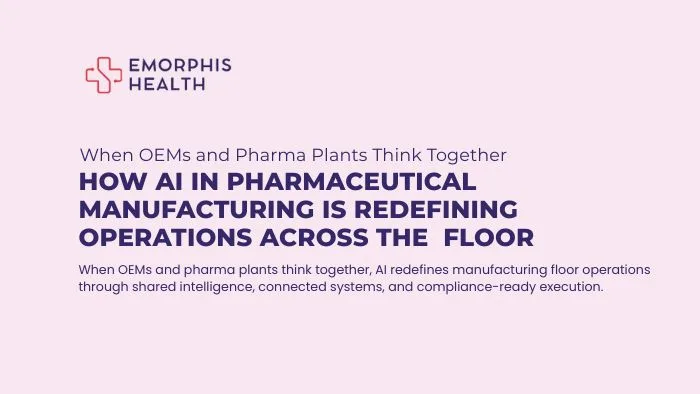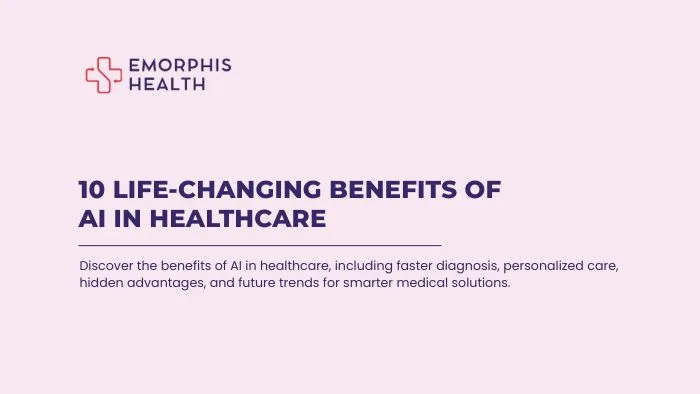Revolutionizing Patient Care with Autonomous Intelligence
See Contents
- 1 Revolutionizing Patient Care with Autonomous Intelligence
- 2 What is Agentic AI?
- 3 Market Analysis of Agentic AI in Healthcare
- 4 Applications of Agentic AI in Healthcare
- 5 Benefits of Agentic AI in Healthcare
- 6 Challenges and Ethical Considerations
- 7 The Future of Agentic AI in Healthcare
- 8 Tools and Platforms for Building Agentic AI in Healthcare
- 9 Conclusion
Agentic AI is redefining the future of healthcare by moving beyond traditional AI systems to autonomous, goal-driven agents capable of reasoning, planning, and acting on behalf of users. In a world where timely, efficient, and accurate healthcare is vital, Agentic AI offers a powerful approach to support clinicians, optimize workflows, and improve patient outcomes.
What is Agentic AI?
Agentic AI refers to AI systems that behave as independent agents with the ability to:
- Set and pursue goals autonomously
- Learn from interactions with their environment
- Make decisions and take actions without continuous human oversight
- Collaborate with humans or other agents
These systems are designed to act proactively and adaptively, making them ideal for dynamic and high-stakes environments like healthcare.
Market Analysis of Agentic AI in Healthcare
According to a 2024 report by Grand View Research, the Agentic AI in healthcare market was valued at USD 538.51 million and is projected to grow at a CAGR of 45.56% from 2025 to 2030. Growth is fueled by automation of repetitive tasks, rising demand for personalized care, and the need to optimize healthcare costs and resources. AI agents are also accelerating research and drug development by analyzing large datasets, helping identify effective compounds faster and at lower costs.


In 2024, healthcare companies held the largest market share (31.16%), leveraging autonomous AI to streamline operations and enhance patient care. These tools assist in early drug discovery by analyzing genetic and chemical data to predict potential treatments.


Regional Trends
- North America led the market with a 54.85% share, driven by advanced healthcare infrastructure, AI adoption, and supportive government policies.
- In the U.S., demand is growing due to innovations in diagnostics, fraud analytics, and personalized care.
- Europe is investing heavily—over USD 200B pledged by the EU in 2025 to advance AI across sectors. The UK and Germany are leading with strong infrastructure and private investments.
- Asia Pacific is growing rapidly, especially in Japan and China, with government support and tech innovation. In China, partnerships like Fangzhou’s with Tencent and Baidu are transforming digital healthcare.
- Latin America, the Middle East, and Africa are also seeing increased adoption of Agentic AI in healthcare through rising investments, awareness, and government-led initiatives.


Agentic AI in healthcare is poised for exponential growth, revolutionizing care delivery across the globe. With the growing market potential and expanding adoption of Agentic AI in healthcare, it’s essential to explore how these technologies are being implemented to transform patient care, clinical workflows, and medical research. Let’s delve into the practical applications of Agentic AI in healthcare and how it’s reshaping the industry.
Applications of Agentic AI in Healthcare
1. Clinical Decision Support Systems (CDSS)
How it works:
Agentic AI integrates with Electronic Health Records (EHRs) and continuously ingests structured and unstructured patient data, labs, vitals, prescriptions, and clinical notes. It uses large language models (LLMs) and knowledge graphs to reason through differentials and predict outcomes.
It compares a patient’s case to millions of similar historical cases, recent medical research, and clinical guidelines, then generates adaptive, evidence-based recommendations.
-
Example: For a patient presenting with chest pain, the agent might cross-check ECG data, troponin levels, and history, and suggest potential diagnoses such as myocardial infarction or pericarditis, ranked by likelihood.
2. Personalized Virtual Health Assistants
How it works:
These agents use Natural Language Processing (NLP) and multi-modal data fusion to interact with patients via voice or chat. They integrate with smart devices, calendars, and sensors to deliver context-aware guidance.
The agent constantly updates its model based on patient behavior, adherence, and preferences to create hyper-personalized interventions.
-
Example: After a morning walk, the assistant may prompt hydration tips, check blood pressure from a wearable, and adjust the day’s activity level based on fatigue patterns.
3. Chronic Disease Management
How it works:
Agentic AI connects with remote monitoring tools glucometers, smart inhalers, BP cuffs—and ingests continuous streams of data. Using anomaly detection and trend analysis, it adjusts patient plans in real-time.
Agents are trained on disease-specific protocols and clinical pathways and can recommend medication changes, schedule check-ins, or send alerts to clinicians.
-
Example: For a hypertension patient, the AI identifies elevated evening BP readings and notifies the provider to reassess medication dosage.
4. Intelligent Medical Imaging Analysis
How it works:
Agentic AI integrates with PACS (Picture Archiving and Communication Systems) to retrieve imaging studies. Using advanced computer vision (e.g., CNNs and transformer-based models), it identifies patterns, lesions, or abnormalities.
The agent prioritizes urgent findings, suggests next steps (e.g., follow-up scan or biopsy), and provides annotated visualizations for radiologists.
-
Example: Detecting signs of a brain hemorrhage, the agent escalates the case and pre-loads clinical notes for the radiologist.
5. Hospital Operations & Resource Optimization
How it works:
Agentic AI accesses real-time data from hospital information systems (HIS), bed management systems, and scheduling software.
It models workflows using reinforcement learning, simulating different scenarios to optimize throughput, reduce patient wait times, and ensure optimal staff utilization.
-
Example: During a staff shortage, the AI redistributes appointments, assigns tasks based on clinician availability, and ensures ICU beds are prioritized for critical cases.


6. Remote Patient Monitoring & Emergency Response
How it works:
AI agents receive live data streams from IoT devices like smartwatches, pulse oximeters, and home sensors.
They continuously analyze these data against individualized thresholds and use event detection algorithms to trigger interventions.
In emergencies, the agent follows predefined protocols, contacting paramedics, notifying caregivers, and unlocking access to the patient’s medical history for responders.
-
Example: When oxygen saturation drops below 85%, the agent escalates care, shares real-time GPS and vitals with EMS, and pre-alerts the hospital ER.
7. Mental Health & Behavioral Support
How it works:
Using sentiment analysis, tone detection, and journaling inputs, agentic AI tracks mental health status. It combines input from daily mood logs, voice tone, and behavioral patterns (e.g., sleep or social activity levels).
Agents employ CBT-based dialogue strategies and monitor progress, escalating care if suicidal ideation or severe anxiety is detected.
-
Example: An agent detects increased isolation and sleep disruption in a user with depression and recommends a virtual therapy session.
8. Clinical Trial Matching & Research
How it works:
Agentic systems mine EHRs using NLP to extract key clinical attributes, demographics, and diagnoses.
Simultaneously, they parse trial registries (like ClinicalTrials.gov) to extract eligibility criteria using rule-based and ML methods.
The AI then matches patients using semantic similarity and probabilistic matching, explaining why a match occurred.
-
Example: A patient with metastatic breast cancer is matched to a HER2-targeted trial after the AI correlates biopsy results, stage, and genomic profile.
9. Administrative Automation and Claims Processing
How it works:
Agents use document AI to extract structured data from physician notes, discharge summaries, and billing forms.
They verify compliance against payer rules, detect coding errors, and auto-fill forms using standardized terminologies (e.g., ICD-10, CPT).
Through RPA (Robotic Process Automation), they interact with payer portals to submit claims and track rejections.
-
Example: After a surgery, the agent codes the procedure, checks for documentation gaps, attaches pre-auth documents, and submits the claim, all without human input.
10. Training & Simulation for Medical Professionals
How it works:
Agentic AI simulates virtual patients with varying behaviors and responses based on clinician inputs.
It uses naturalistic decision modeling to mirror real-world reactions, altering vitals, speech, or pain response depending on trainee choices.
Agents also deliver real-time feedback, suggest alternative actions, and adjust complexity dynamically as the learner progresses.
-
Example: A trauma simulation where the AI-controlled patient exhibits signs of shock. If not treated promptly, the agent simulates decompensation, reinforcing urgency.
Benefits of Agentic AI in Healthcare
The rise of Agentic AI in healthcare brings a transformative impact across clinical, administrative, and operational domains. These AI-driven agents act autonomously, continuously learning and adapting to dynamic healthcare environments. Here’s a closer look at the key benefits:
a. Increased Efficiency
Agentic AI streamlines repetitive and time-consuming tasks such as documentation, scheduling, and patient triage. By automating these tasks, AI agents in healthcare free up valuable time for doctors and nurses to focus on direct patient care.
-
Example: An autonomous AI agent automatically summarizes patient visits and enters structured data into the EHR.
b. Faster Decision-Making
Healthcare providers benefit from real-time, data-driven recommendations. Agentic AI in healthcare processes large volumes of medical data instantly, helping clinicians make informed decisions quickly—especially in time-sensitive cases like trauma or cardiac arrest.
-
Example: An AI agent detects early sepsis patterns before lab results confirm infection.
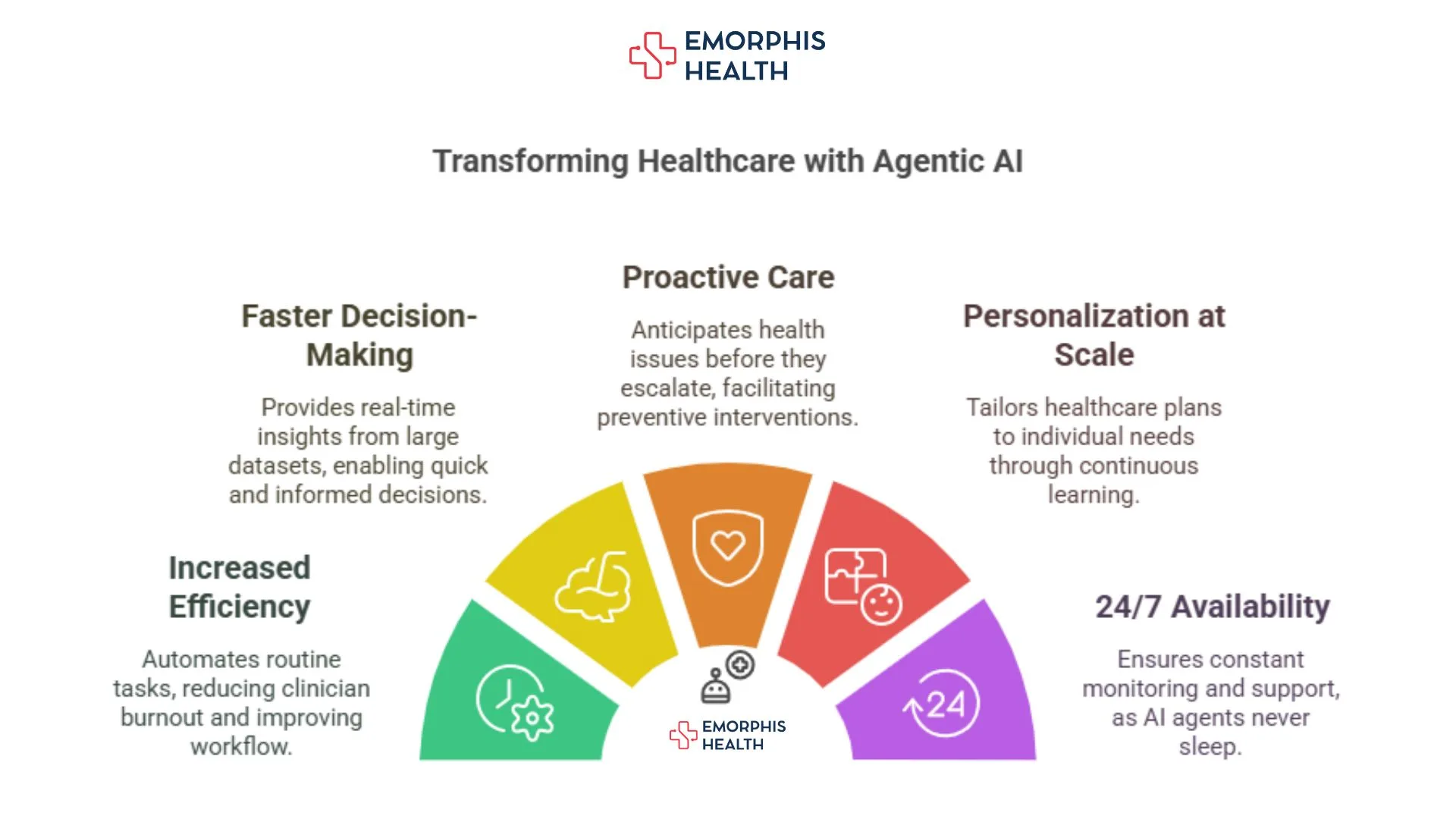

c. Proactive and Preventive Care
Unlike traditional systems, agentic healthcare AI anticipates patient needs. It flags anomalies before they become emergencies, enabling earlier interventions and better outcomes.
-
Example: A smart agent tracking diabetic patients may alert care teams about declining glucose trends days in advance.
d. Personalization at Scale
Each patient receives a custom care plan informed by real-time monitoring, genetic profiles, lifestyle patterns, and clinical history. These AI agents in healthcare learn individual behaviors and adapt care accordingly.
-
Example: A cancer patient’s treatment plan is adjusted weekly based on tumor response and wearable data.
e. 24/7 Monitoring and Support
Autonomous agents operate around the clock. This ensures continuous patient monitoring—even after hospital discharge—and reduces readmissions.
-
Example: An AI agent tracks vital signs at night and alerts clinicians to nocturnal hypoxia in high-risk patients.
f. Enhanced Patient Engagement
By providing daily health nudges, virtual coaching, and on-demand answers, agentic AI in healthcare improves patient adherence and satisfaction.
-
Example: A heart failure patient receives medication reminders and low-sodium recipe suggestions from their virtual health assistant.
Challenges and Ethical Considerations
While the advantages of Agentic AI in healthcare are immense, the technology introduces ethical and operational challenges that must be addressed to ensure safe, equitable, and responsible deployment.
i. Data Privacy and Security
Agentic AI relies heavily on sensitive personal health data. Ensuring that this data is securely stored, encrypted, and accessed only by authorized entities is critical.
-
Risk: A breach in an AI agent’s cloud platform could expose thousands of medical records.
ii. Trust and Transparency
Clinicians and patients may hesitate to rely on decisions made by autonomous AI in healthcare. Clear explainability and traceability of the agent’s decisions are essential.
-
Solution: Implement explainable AI (XAI) frameworks that show how conclusions were reached.
iii. Bias and Fairness
AI agents trained on non-representative datasets can perpetuate biases, leading to unequal care across demographic groups.
-
Solution: Ensure diverse training datasets and perform fairness audits of AI models regularly.
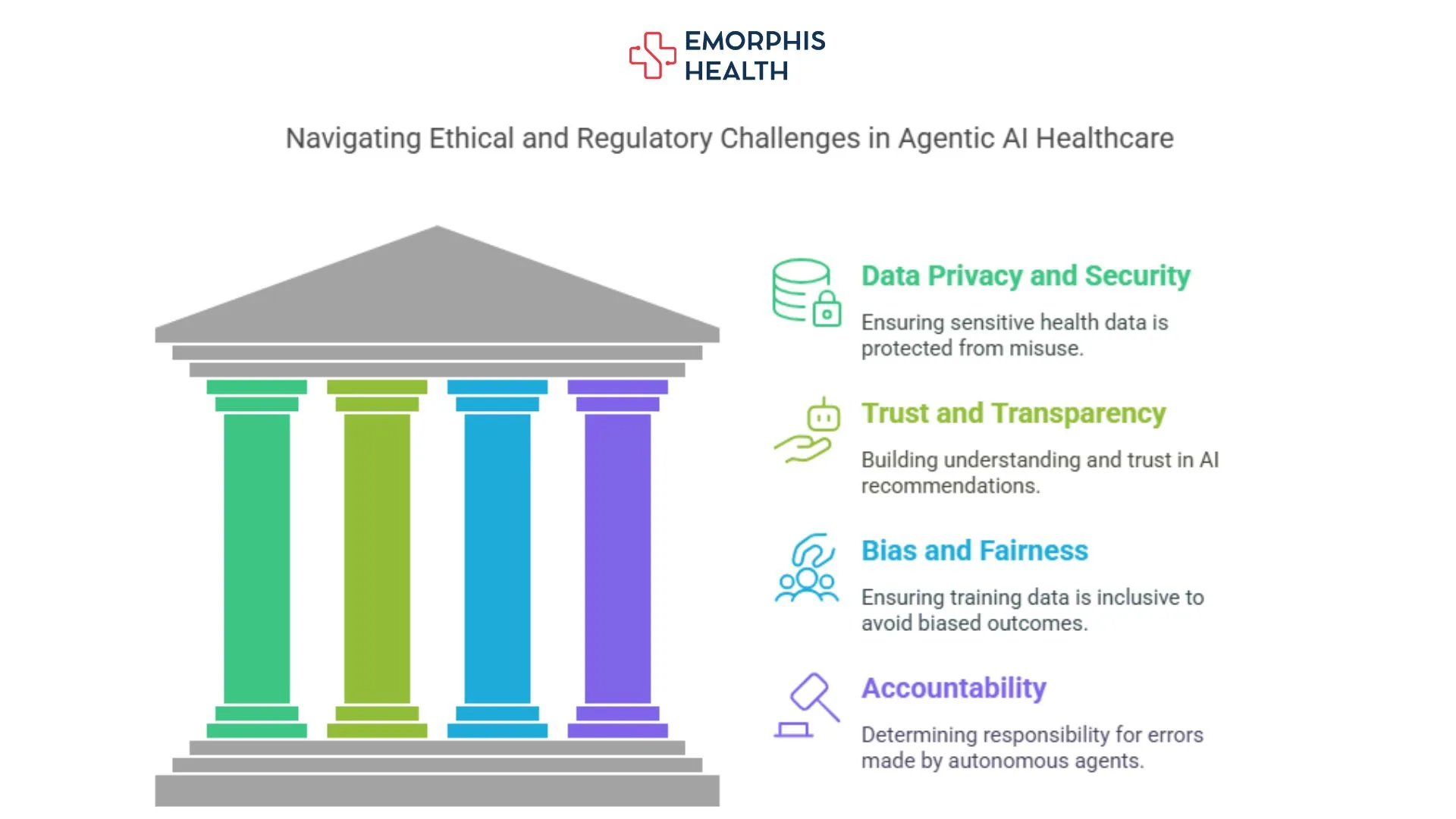

iv. Accountability and Liability
When an autonomous AI agent makes a clinical error, it’s unclear whether responsibility lies with the provider, the vendor, or the hospital.
-
Need: Clear legal and ethical frameworks to define accountability for autonomous decisions.
v. Regulatory Compliance
Agentic AI in healthcare must adhere to strict laws like HIPAA (U.S.), GDPR (Europe), and MDR (EU Medical Device Regulation).
-
Example: AI agents handling European patient data must enable data subject rights such as deletion and consent revocation.
The Future of Agentic AI in Healthcare
As the healthcare ecosystem continues to digitize, Agentic AI in healthcare is poised to become foundational to how care is delivered. The next generation of AI agents will be more intelligent, collaborative, and ethically aligned.
1. Integration with Ambient Intelligence
AI agents will be embedded in smart hospital infrastructure—monitoring environmental factors like noise, lighting, and patient movement to enhance comfort and safety.
-
Example: Room temperature adjusts automatically based on patient restlessness detected by an AI agent.
2. Collaborative Multi-Agent Systems
Rather than working in isolation, multiple AI agents will collaborate—across specialties like oncology, cardiology, and psychiatry—for comprehensive care planning.
-
Example: A primary care agent shares data with a cardiology agent to co-manage a patient with both diabetes and heart disease.
3. Human-in-the-Loop (HITL) Architectures
Agentic systems will maintain clinician oversight in critical decision-making loops, combining the intelligence of machines with the empathy and judgment of humans.
-
Example: AI suggests a treatment, but the doctor can approve, reject, or modify the recommendation.
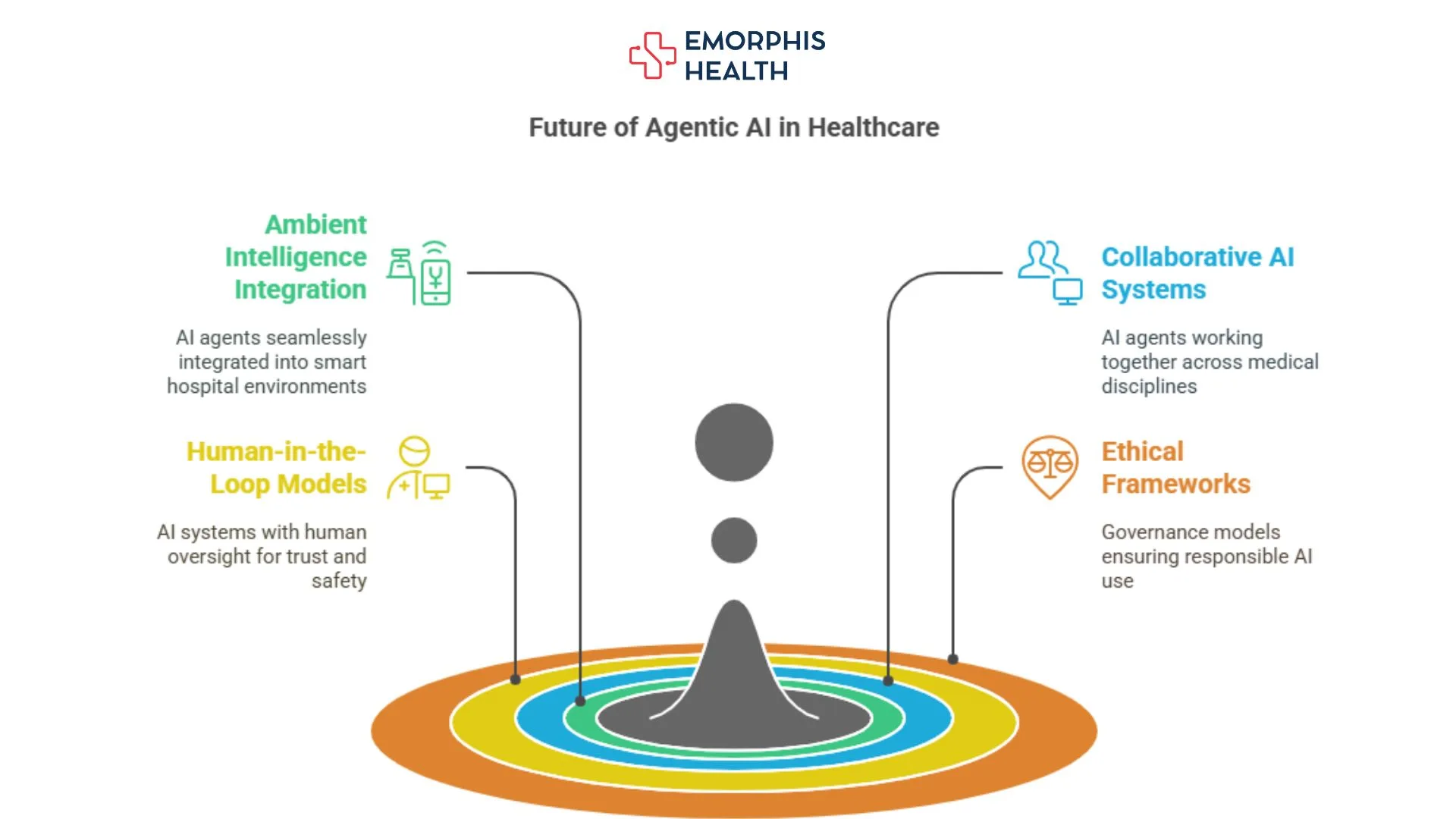

4. Ethical AI Frameworks and Governance
Hospitals and governments will develop strict frameworks to ensure the responsible deployment of agentic healthcare AI. This includes setting limits on autonomy, ensuring fairness, and upholding human rights.
-
Example: Hospital ethics boards review and approve AI agent deployments, just like new clinical interventions.
Tools and Platforms for Building Agentic AI in Healthcare
To harness the full potential of Agentic AI in healthcare, developers and researchers rely on a suite of powerful tools, frameworks, and APIs:
1. LangChain
A flexible framework for building goal-directed, memory-augmented AI agents. Perfect for chaining complex healthcare queries and tasks.
2. AutoGPT / BabyAGI
Popular for prototyping autonomous AI agents capable of self-directed execution of multi-step healthcare tasks like research, report generation, and diagnosis simulation.
3. Healthcare APIs and Standards
APIs like FHIR, HL7, and DICOM allow agents to interact seamlessly with hospital systems, EHRs, and imaging platforms.
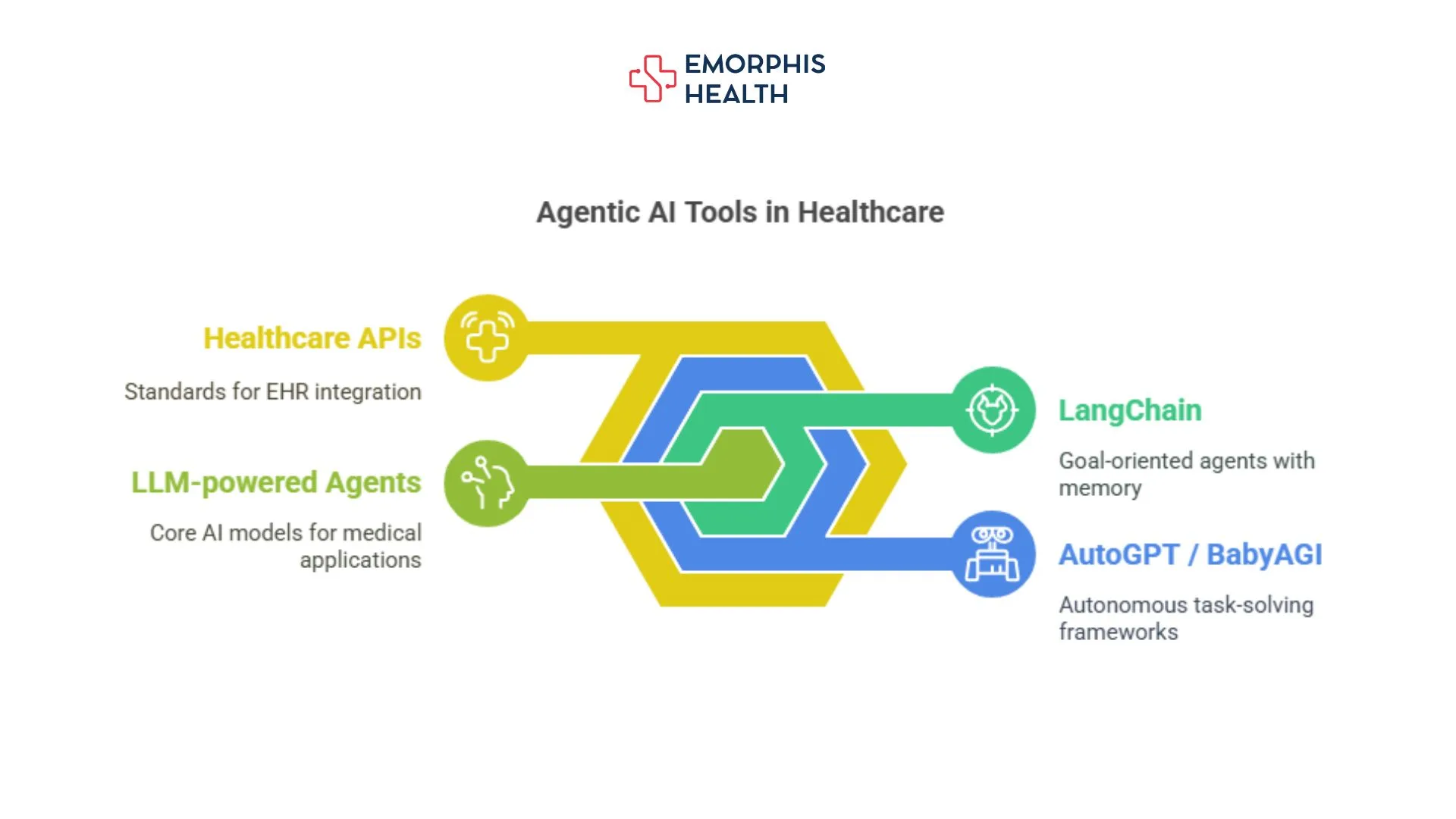

4. LLM-Powered Agents
Large language models (LLMs) like GPT-4, Med-PaLM, and BiomedLM are used to power healthcare AI agents with contextual understanding and domain-specific expertise.
5. Event-Driven Architecture
Healthcare-specific agentic systems are increasingly adopting event-driven models to respond to real-time triggers from IoT devices and clinical systems.
Conclusion
Agentic AI in healthcare is transforming how we deliver care, improve patient outcomes, and streamline healthcare systems. From reducing clinician burnout to offering personalized 24/7 support, AI agents are unlocking new efficiencies and proactive care. But as we embrace this innovation, we must also address challenges like data privacy and ethical considerations.
How can your practice or organization leverage the power of autonomous AI? Are you ready to integrate agentic AI in healthcare for smarter, more personalized care? The future of healthcare is here are you ready to be part of it?



